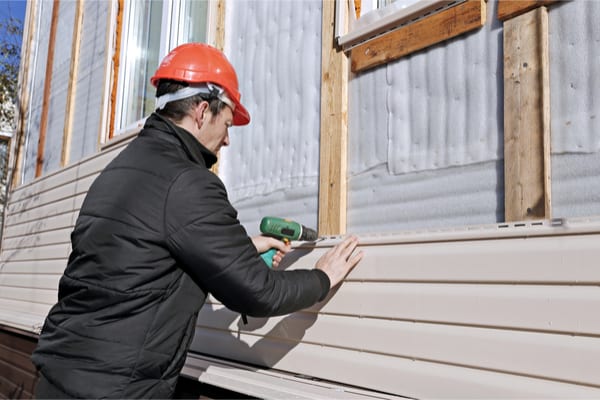Siding does much more than enhance your home’s curb appeal with cosmetic value. It also protects your home. Much like insulation, siding shields your property from the elements. It acts as a barrier to prevent rain, snow, and harsh winds from seeping into your house. Siding also has other purposes, such as deterring dirt, moisture, and insects.
Siding has several important functions, starting with its architectural value. After a home is framed, it is sheathed with particle board. As particle board is not moisture-resistant, it must be protected. Often times, tar paper or house wrap is used to create a waterproof barrier and to add an extra layer of insulation. However, even wrap needs to be protected. Different types of siding, such as vinyl, aluminum, or wood panels, provide this protection. Some sidings are more durable than others, while some may offer better aesthetic value. Sidings for homes can also be found at various price points.
Depending on your personal tastes, where you live, and what your budget allows, you can choose from a wide range of materials. There are benefits and downfalls to each type of siding. According to HGTV, the six most popular types of siding are Vinyl, Wood, Brick, Fiber-Cement, Stucco and Stone. Here’s how they break it down the options, so you can pick the Siding style that’s right for you:
Vinyl siding
The low cost, versatility and easy maintenance of vinyl siding has helped it become the most popular siding choice in the United States. While some design professionals and homeowners are turned off by the “plastic look” of some vinyl siding products, the variety of colors and styles available helps explain this siding’s popularity. Requiring few tools to install and available at home improvement stores, this is an option for those looking for a do-it-yourself product. Since mistakes can be costly, make sure to follow instructions from the manufacturer and take advantage of online how-to videos.
Wood siding
Commonly used for bungalow, Cape Cod and cottage exteriors, wood siding offers a rich look and is durable if maintained properly. If you are attracted to this look keep in mind that it requires periodic maintenance (chalking and painting or staining to prevent weather damage) and is susceptible to insect or rodent attacks. Depending on maintenance, your rich wood siding can last from 10 to sometimes 100 years.
Wood siding comes in clapboard (also known as lap or bevel siding) as well as shakes and shingles. Clapboard siding uses planks of wood installed horizontally with an upper piece that overlaps the lower piece. Western red cedar and redwood, woods known for being attractive and durable, are considered the best choices.
More uniform in appearance but thinner than shakes, shingles give you a smooth and consistent look. They can be cut into different shapes to add visual interest to your exterior. Some manufacturers also offer shingles treated with fire-retardant chemicals, often a requirement in high-risk locations. Be sure to check into the local rules in your area. Wood siding typically costs around $5 to $10 per square foot installed. That doesn’t count additional cost for painting or staining.
Brick siding
Made from fired clay, genuine brick comes in different sizes and textures. Brick is commonly found on Colonial, Tudor and English cottage exteriors, providing a beautiful look that has been used for hundreds of years and has stood the test of time. These days brick siding is usually a veneer constructed outside of a home’s wood frame structure, with mortar used to hold the bricks together.
Since water can penetrate brick veneers, a membrane installed between the brick veneer and house can protect the structure. Under normal conditions and when installed correctly brick siding can last the life of your house. Installing brick is labor-intensive, so the cost is on the higher end compared to other siding options. Typically, brick siding costs around $6 to $15 or more per square foot installed.
Fiber-Cement siding
Offering the look of masonry, stucco or wood at a lower cost, fiber-cement siding has become a popular siding choice for many homeowners. Fiber-cement siding is low-maintenance, non-flammable and termite-resistant. Available in a range of styles and textures, factory painting or finishes are highly recommended.
On the other side, fiber-cement siding could encounter possible moisture-related problems, and older homes built before the late 1980s may have siding that contains asbestos and requires a professional abatement contractor for removal. The average cost is $6 to $12 per square foot installed (cost higher with trim), and the siding will last 25 to 50 years, depending on manufacturer.
Stucco siding
Traditional stucco is made from building sand, Portland cement, lime and water. A waterproof barrier paper and galvanized-metal screening are applied over wood walls before stucco is added to provide a good base for the stucco and protect the walls underneath. While stucco can be applied to homes with brick and stone surfaces, the classic look is commonly found on Mediterranean, ranch and Spanish-mission exteriors.
Because stucco is very rigid, careful installation can help reduce the possibility of unwanted cracks. When stucco siding is properly installed and maintained, it can last the lifetime of the house.
Stone and Stone-Veneer siding
The natural beauty and durability of stones like granite and limestone are appealing to homeowners who want a siding that adds texture and visual interest to their exterior. Because stone is more expensive than other siding options — and can be difficult to add to an existing home — concerns about costs should be considered.
More lightweight and less expensive than natural stone, stone-veneer siding comes in natural and synthetic materials. There are many styles available that help enhance your home’s curb appeal. Annual cleaning with a hose and inspection of the siding helps ensure it will last the life of the house. The average cost of stone is around $10 to $30 per square foot installed, and if maintained properly, can last the lifetime of house.
—
Photo Credit: Kingarion / Shutterstock.com
